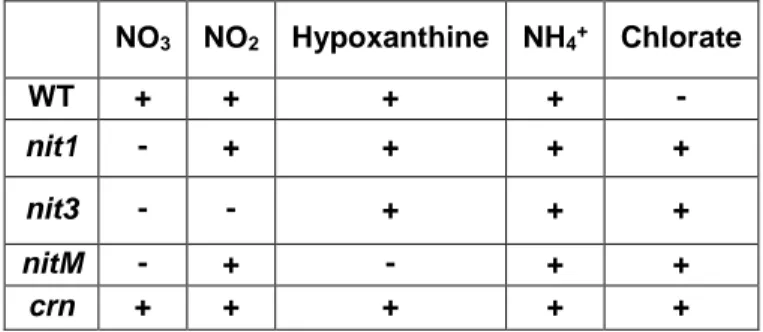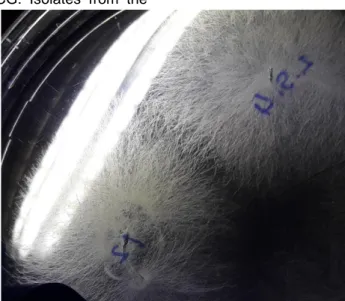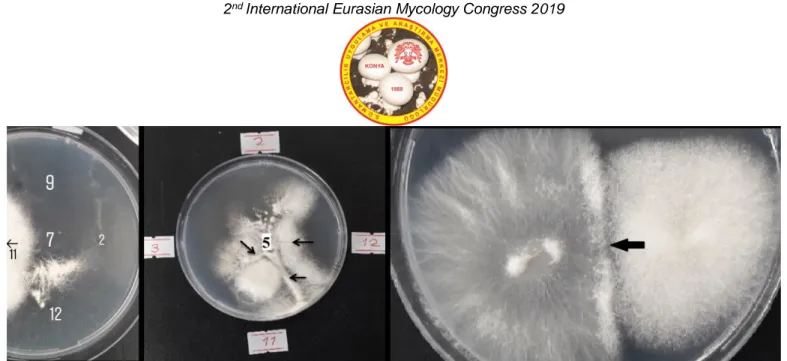Geliş(Recevied) :20/09/2019 Araştırma Makalesi/Research Article
Kabul(Accepted) :04/12/2019 Doi:10.30708.mantar.624149
Determination of Genetic Diversity by Classification of Vegetative
Compatibility Groups of Tomato Pathogen Fusarium oxysporum
in Aegean Region
Tanay UZGAN
*1, Yiğit TERZİ
2, Füsun Bahriye UÇAR
3 *Corresponding author: Tanayuzgan92@gmail.comEge University, Faculty of Science, Department of Biology, İzmir, Turkey 1Orcid ID: 0000-0003-4784-4393/ Tanayuzgan92@gmail.com
2Orcid ID:0000-0003-2572-7508/ yigit.trz@gmail.com 3Orcid ID:0000-0002-8140-7448/ fusun.b.ucar@gmail.com
Abstract: Tomatoes are one of the widely grown vegetables worldwide. Fusarium oxysporum (Schltdl, 1824) is a pathogen of plants which causes vascular wilt. The phytopathogenic strains cause destructive vascular wilt disease and often limit the production. However, isolates in the same vegetative compatibility group (VCG) are more genetically similar than vegetatively incompatible ones. Therefore, VCG tests are useful to determine genetic diversities or similarities.
Sixty Fusarium oxysporum samples were taken from twenty different regions. Samples were phenotypically identified as Fusarium sp. (Link, 1809) according to microscopic observations and media characteristics. After identification, nitrate non-utilizing (nit) mutants were determined. Then, they were divided into four phenotypic mutant classes and then vegetative compatibility tests are performed.
Six nit1 mutants, six nitM mutants and, five nit3 mutants are found for every district. Sixty-six crossing show that twenty-seven pair of samples are determined as same VCG, thirty-nine couple of samples is defined as different VCG.
According to these results, minimum genetic variants have been found between samples. Our study could help to understand linkages between parasexual recombination and pathogenicity.
This study financially supported by Ege University Scientific Research Projects Coordination Foundation.
Key words: Fusarium oxysporum, Vegetative compatibility, Fungus, Tomatoes
Ege Bölgesindeki Domates Patojeni Fusarium oxysporum’un Vejetatif
Uyumluluk Gruplarının Belirlenmesi İle Genetik Çeşitliliğ Saptanması
Öz: Domates bitkisi dünya çapında geniş dağılıma sahip bir bitkidir. Fusarium oxysporum
(Schltdl, 1824) ise domateste fide baygınlığına sebep olan bir patojendir. Fitopatojen olan suşların sıklıkla yıkıcı vasküler baygınlık ile üretimin sınırlanmasına sebep olurlar. Aynı vejetatif uyumluluk grubunda (VCG) bulunan izolatlar, genetik olarak birbirine uyumsuz olanlara göre daha fazla genetik benzerliğe sahiptirler. Bu sebep ile VCG testleri genetik çeşitliliği veya benzerliği saptamak için kullanışlı yöntemlerdir.
Altmış F. oxysporum yirmi farklı bölgeden toplanmıştır. Sonrasında, örnekler fenotipik olarak mikroskopik gözlemler ve besiyeri karakteristiklerine göre Fusarium sp. (Link, 1809) olarak tanılanmıştır. Tanılama sonrasında, nitratı kullanamayan (nit) mutantları tanılanmıştır. Sonrasında
örnekler dört farklı fenotipik mutant sınıfına ayrılmıştırlar. Daha sonrasında vejetatif uyumluluk testleri gerçekleştirilmiştir.
Bu çalışmada, her bir bölge için altı adet nit1 mutantı, altı adet nitM mutantı, beş adet nit3 mutantı saptanmıştır. Altmışaltı çaprazlama sonucunda; yirmi yedi çift örnek aynı VCG’de gruplanmıştır, otuz dokuz çift örnek ise farklı VCG’de bulunmuştur.
Bu sonuçlara göre, toplanan örnekler arasındaki minimum genetik çeşitlilik belirlenmiştir. Bu çalışma paraseksüel rekombinasyon ile patojenite arasındaki ilişkinin anlaşılabilmesine katkıda bulunmayı hedeflemektedir.
Bu çalışma Ege Üniversitesi Bilimsel Araştırma Projeleri Koordinasyon Birimi tarafından desteklenmiştir.
Anahtar kelimeler: Fusarium oxysporum, Vejetatif uyumluluk, Fungus, Domates
Introduction
F. oxysporum (Schltdl, 1824) is a necrotrophic pathogen causing a disease known worldwide as tomato wild. It starts with yellowing the leaves by clogging the plant veins under appropriate conditions, resulting in the whole plant dying. Tomato is an essential crop in terms of agricultural worldwide, and it is an important model organism in molecular and genetic studies of resistance mechanisms (Zhao et al., 2018; Okungbowa & Shittu, 2012).
The studies on F.oxysporum have been carried out with pathogenic strains as they cause damages such as vascular wild, root decay, and cellular destruction in more than 150 plants. Examples include bananas, cotton, tomatoes, cabbages, many flowering plants, trees, and agricultural importance other plants. Non-pathogenic strains, however, are generally more frequent and more diverse than pathogenic ones (Bacon & Yates, 2006; Gordon & Martyn, 1997).
When two different mycelia of different genotypes combine, a bi-nucleated form of mycelium occurs. In this mycelium, two different haploid strains are present at the same time and undergo mitotic division within the same cytoplasm. In this type of cytoplasm, more than one genetically different nucleus containing, are called heterokaryon. In this case, cell fusion and diploidization rarely take place. In the meantime, mitosis can appear infrequently. With these divisions, the diploid nucleus becomes a haploid. During the mitotic phase of this diploid nucleus, recombination between homologous chromosomes can occur. For this reason, the parasexual system is a genetic recombination system without meiosis (Pál et al., 2007).
In most of their lives, most fungi are haploid and do not show sexual reproduction. While in a vegetative state,
fungi may undergo mitotic recombination known as hyphal fusion, karyogamy, and parasexual cycle. Finding the proper partner is crucial for the mitotic recombination of the parasexual cycle as well as a sexual one (Moore et al., 1978).
The first step of the parasexual cycle in fungi is pheromone secreting. Pheromone production genes are controlled by heterokaryon self-incompatibility (hsi) genes and receptor genes. hsi and vegetative incompatibility (vic) genes are responsible for the fusion step in which hyphae anastomosis occurs (Leslie, 1993).
Different hyphae can utilize the physiological and genetic advantages of heterokaryons without anastomosis and risk. The incompatibility of the two strains is due to genetic similarities and differences in the heterokaryon incompatibility (het) and vic loci. The isolates found in the same vegetative compatibility group (VCG) have the same alleles in vic and het loci. Those indifferent VCGs differ in terms of at least one allele in vic and het loci. The more vic loci in the cell, the more diverse the possible VCGs are (Glass et al., 2000; Klein & Correll, 2001).
As the number of possible vic loci increases, so does the number of VCGs in which organisms can be found. If an organism crosses with its lineage and becomes involved in more than one compatible VCG, the parental organism has so many different alleles. For example, the presence of two different alleles at one locus of parental of the lineage involved in two VCGs is shown as 21 in different VCGs. If there are differences in the two loci, this gives us four (22) different VCGs. Fusarium moniliforme has 10 vic loci that control vegetative compatibility. This shows us that 210 different VCGs can be found. If two different strains are clones made from the same strain, then they must be in a different VCG; but the presence of these strains in different VCGs does not mean they are clones (Krnjaja et al., 2013).
For this reason, the use of different nitrate non-utilizing (nit) mutants for VCG tests is preferred because it can quickly gain strain phenotypic discrimination and targets essential genes (Puhalla, 1985).
Material and method
1-Collection of samples
Three different fields of Karakuyu village of Menderes in İzmir were visited, and twenty different disease regions were detected in the fields. Three plants are collected from each of these regions, reaching a total of sixty samples.
Plant samples were selected considering Fusarium wilt and characteristic features. Browning in xylems and leaves are selected during the collection, which is specific to this disease. the disease starts only on one side of plants, top leaves were seen as a yellow flag. Therefore, in the early period this situation called as "yellow flag" in fields (ignjatov et al., 2012).
2-Microbiological Analysis
First, samples are isolated with Komada's Medium just after three minutes of surface sterilization with 0,01 % mercury chloride (Alborch et al., 2009; Komada, 1975). After that, samples were sliced into 1mm disks for transferring to medium. Then, all samples were analyzed by their micro- and macro-morphological characteristics by using Malt Extract Agar (MEA), Potato Dextrose Agar (PDA) ve Dikloran Gliserol Agar (DG18) (Samson et al., 2010).
As a result of the observations made under the microscope, microconidia and macroconidia of organisms were compared with the literature in terms of shape, size, and structure. Studies were continued with isolates that matched the targeted morphology.
3-Determining of Nitrate Non-utilizing Mutants
Nitrate non-utilizing (nit) mutants were found by the medium which contains 3% potassium chlorate (KClO3). Chlorate is nitrate analog which can be used by nitrate reductase enzyme. This enzyme transform chlorate into
chlorite, which is extremely toxic for fungi. When wild type organisms were die, mutants can survive because mutants do not have nitrate reductase enzyme (Zainudin et al., 2009).
Four different media are used for the detection of nit1, nit3, nitM, and crn mutants. The first one contains nitrate as the sole nitrogen source; the second one contains nitrite as the sole nitrogen source; the third one contains hypoxanthine as the sole nitrogen source; the fourth one contains ammonium tartrate as the sole nitrogen source which is presented in table 1. The petri dishes is stored at 25°C for 10-15 days. As a result of the process, it is determined which sub-mutant group. Organisms are grouped according to the combinations on media in which the growth looks like the wild type form. In the negative result, growth is thin or morphologically damaged. The mutants are recovered with minimal media (Krnjaja et al., 2013).
Table 1. Combinations of different nitrogen sources and mutant types by their growth like a wild type.
NO3 NO2 Hypoxanthine NH4+ Chlorate
WT + + + + -
nit1 - + + + +
nit3 - - + + +
nitM - + - + +
crn + + + + +
4-Vegetative Compatibility Group Tests
VCG tests are performed in minimal medium containing nitrate as the sole nitrogen source. During this process, the nit1 mutant strains are planted in the center of the petri dish, while the nit3 and nitM mutants are placed around it. Crn mutants were excluded from the study because they were able to grow in the presence of nitrate as the sole nitrogen source and were resistant to chlorite. In order to prevent possible errors, mutants were placed not to exceed four in the surround of nit1 mutants on the petri dish, which shown as figure 1.
Figure 1. Locations of mutants on petri dish. The petri dishes are kept at 25°C. for 10-15 days,
and if the micelles have grown by combining micelles, the two crossing strains are grouped in the same VCG. If there is no reproduction or a zone of death occurs, these two strains are grouped in different VCG. Isolates from the
same VCG are also tested by dual cross-control again. At the end of 7-10 days, hyphae begin to contact each other, as shown in figure 2. If a positive result occurs, dam form will occur between 10-15 days, as shown in figure 3.
Figure 3. Example of vegetative compatibility group tests. Arrows indicate the formation of the dam form between the isolates. In the first frame, 12 to 7 and 11 to 7 are in the same VCG while 9 to 7 and 2 to 7 are in different VCG. In the second frame, between 5 to 11, between 11 to 12 and between 5 to12 dam forms have occurred. In the last frame, the form
of the dam is seen obviously.
Results
1-Nitrate Non-utilizing Mutants
Nit mutants were obtained from all samples except seven of the sixty samples. Nit mutants were categorized according to the media in which they were produced. Their results show which groups they belong to. This categorization takes place with the obtained medium combinations.
The desired mutant group was not detected in 3 of 20 regions. In the remaining 17 regions, six nit1 mutants, six nitM mutants, and five nit3 mutants were obtained. The crn mutants are separated because they will not use in VCG assays. No nit3 or nitM mutant was detected in any region where the nit1 mutant was detected, and vice versa. A total of 36 crn mutants were obtained, and all isolates accounted for 60% of the crn mutant. The nit1, nit3, and nitM mutants from each region were recovered in the minimal medium for use in VCG assays.
2-Vegetative Compatibility Group Test Results
As a result of 66 crossings; 8 nit1 x nit3 pairs are grouped in the same VCG and 19 nit1 x nitM pairs are grouped in the same VCG. It was determined that 27 pairs of organisms were in the same VCG and 39 pairs of organisms were in different VCGs.
Discussion
Chlorate resistant and nitrate utilizing crn mutants are rare mutants found in Aspergillus nidulans and Fusarium oxysporum. However, at the same rate, they are abundant in these species. The crn1 locus of nit3 was found to be directly associated with the control of the nitrate reductase pathway and is thought to be allelic. The crn5 locus was found to be linked to the region where nit1 encodes the gene for the nitrate reductase enzyme (Klitticht & Leslie, 1999). Because of these, it was not surprising to see that 60 % of all samples were crn mutants. The presence of a large number of crn mutants is inevitable. In this study, the isolation results of the mutants were consistent with the literature. The categorization of the results according to the regions in which they were collected constituted an important distinction in terms of geographical distribution.
Knowing the minimum diversity found in the field has a vital role in finding the source of outbreaks, in determining pathogen distribution and in detecting resistant strains. It is critical issue to understand mechanisims of VCGs therefore more studies are required on this topic in future. By observing the genetic distribution of organisms that can cause significant outbreaks such as Fusarium oxysporum, it may be possible to detect these outbreaks in advance. Therefore, vcg tests have great potential for today's studies.
The results of 27 same VCGs found in this study show us the minimum diversity in the population. While these 27 pairs of organisms are similar in many genes, but they also differ by key genes. This difference may be related to nutrition as it results from a nitrogen-based separation. The phenomenon identified as pathogenicity
for fungi is also basically a form of nutrition, and the connection between pathogenicity and VCGs should be investigated in detail. Perhaps with the early detection of outbreaks in the future, losses can be minimized.
References
Alborch, L., Bragulat, M.R., & Cabanes and F.J. (2009). Comparison of two selective culture media for the detection of Fusarium infection in conventional and transgenic maize kernels. Letters in Applied Microbiology, 50 (3), 266-294. Bacon, C. W., & Yates, I. E. (2006). Endophytic root colonization by Fusarium Species: 21 Histology, plant interactions, and
toxicity in microbial root endophytes. Springer Berlin Heidelberg, 133–152.
Glass, N.L., Jacobson, D.J. & Shiu, P.K. (2000). The genetics of hyphal fusion and vegetative incompatibility in filamentous ascomycete fungi. Annual Review of Genetics, 34, 165-186.
Gordon, T. R. and Martyn, R. D. (1997). The evolutionary biology of Fusarium oxysporum, Annual Review of Phytopathology, 35, 111–128.
Ignjatov M., Milošević D., Nikolić, Z., Gvozdanović-Varga, J., & JovičićGordana Zdjelar J. (2012) Fusarium oxysporum as causal agent of tomato wilt and fruit rot, Pesticides and Phytomedicine, 27(1), 25–31.
Klein, K.K., & Correll, J.C. (2001). Vegetative compatibility group diversity in Fusarium. In B.A. Summerell, J.F. Leslie, D. Backhouse, W.L. Bryden, & L.W. Burgess (Eds.), Fusarium - Paul E. Nelson Memorial Symposium, 392.
Klitticht, C.J.R., & Leslie, J.F. (1999) Chlorate-resistant, nitrate-utilizing mutants of Fusarium, J. Gen. Microbiol., 721- 727. Komada, H. (1975) Development of a selective medium for quantitative isolation of Fusarium oxysporum from natural soil, Rev.
Plant Protec. Res., 8 (13), 114-124.
Krnjaja, V., Lević, J., Stanković, S., & Vasić, T. (2013). The use of vegetative compatibility tests for identification of biodiversity of phytopathogenic fungi, Pestic. Phytomed., 28 (3), 157–165.
Leslie, J.F. & Summerall, B.A. (2006). The Fusarium Laboratory Manual, Blackwell Publishing, 388. Leslie, J.F., (1993). Fungal vegetative compatibility, Ann. Rev. Phytopathol., 31, 127-150.
Link, H.F., (1809). Observationes in ordines plantarum naturales, Dissertatio I. Magazin der Gesellschaft Naturforschenden Freunde Berlin. 3(1):3-42
Moore, D., Robson, G.D., & Trinci, A.P.J. (1978). 21st Century Guidebook to Fungi, Second Edition, Cambridge University Press 7.5, 1-7.
Okungbowa, F. I., & Shittu, H. O. (2012). Fusarium wilts: an overview, Environ. Res. J., 6 (2) 122-134.
Pál, K., Diepeningen, A.D., Varga, J., Hoekstra, R.F., Dyer, P.S., & Debets, A.J.M. (2007). Sexual and vegetative compatibility genes in the aspergilli, Stud. in Mycol., vol. 59, 19-30.
Puhalla, J.E. (1985). Classification of strains of Fusarium oxysporum on the basis of vegetative compatibility, Can. J. Bot., 63(2), 179-183.
Samson, R.A., Houbraken, J., Thrane, U., Frisvad, J.C., & Andersen, B. (2010). Food and indoor fungi, CBS Laboratory Manual Series, 192-193.
Snyder, W.C. & Hansen, H.N. (1940). The species concept in Fusarium. Amer. J. Bot., 27, 64-67
Zainudin, N.A.I.M., Ismail, N.A., Nor, N.M.I.M., Razak, A.B., Sidique, S.N.M., & Salleh, B. (2009). Nitrate non-utilizing mutants and vegetative compatibility groups of Fusarium proliferatum and f. sacchari isolated from rice in the peninsular malaysia and kalimantan, Indonesia, J. Plant Protect. Res., 49 (2) 233-238.
Zhao M., Ji H., Gao Y., Cao X., Mao H.Y., & Ouyang S-Q. (2018). An integrated analysis of mRNA and sRNA transcriptional profiles in tomato root: Insights on tomato wilt disease, PloS ONE, vol. 13(11), 238.


